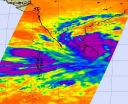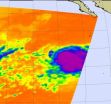(Press-News.org) Researchers at Case Western Reserve University have found a way to create three-dimensional maps of the stress that circulating blood places on the developing heart in an animal model – a key to understanding triggers of heart defects.
The team has begun testing the technology to uncover how alcohol, drugs and other factors set off events that result in defects found in newborn humans.
Passing blood cells drag on the endothelial cells that line the growing heart, a phenomenon called shear stress, which has been linked to changes in gene expression that results in defects, most often in the valves. But precisely how they're connected is unclear.
"Alcohol exposure may affect shear stress by modulating the heart rate, but it may also involve vigor and/or timing of the contraction," said Andrew Rollins, associate professor of biomedical engineering and senior author of the new study. "Now that we have the tool, we can start to figure that out."
"We're analyzing early and late development of the heart and trying to make the connections that result in valve dysfunction," said Lindsy M. Peterson, a PhD student in Rollins' lab and lead author. Their work is published in the current online issue of the Optical Society of America's journal Biomedical Optics Express.
The pair teamed with research assistant professor Michael W. Jenkins; senior research associate Shi Gu; Lee Barwick, an undergraduate researcher now at Brigham Young University; and Michiko Watanabe, a professor of pediatrics at Case Western Reserve School of Medicine.
To look at the structure of the developing heart and blood flow, the researchers modified a technology called Doppler optical coherence tomography. Called OCT for short, they shine an infrared laser on the heart.
The reflections measured at various depths are used to create a three-dimensional image in much the same manner submariners use sonar to picture their surroundings in the deep sea. But the researchers add the dimension of time, creating movies of blood flow through the structures, needed to map shear stress.
They take their first images at two days, during a stage of heart development called cardiac looping. This is when the simple straight tube that's an embryo heart turns clockwise into a helix, forming the beginnings of two atria and two ventricles. They take more images at three days and again at eight days, when the septum, the wall between the left and right sides of the heart, has formed.
Working with Ganga Karunamuni, a pediatrics research associate at the school of medicine, the team is now pursuing a slate of experiments testing the quail heart model's response to alcohol exposure and will also test exposure to mental health drugs called selective serotonin receptor inhibitors. Alone or together, they can alter shear stress.
They are exposing the model to alcohol at a stage called gastrulation, when the embryo changes from two sheets of cells to a multi-layered organism.
This is a critical stage for induction of birth defects, Peterson said. In humans, it's an early stage when a woman may not know that she is pregnant.
Rollins said clinical applications are a long way off but the team has begun talking about possibilities.
"If it became feasible to screen a fetus for abnormal heart function," he said, "it might be possible to intervene with drugs, with gene therapy." Or, by using non-invasive pulses of infrared light to make the heart contract on demand – another technology the team is developing with clinical colleagues in Pediatric Cardiology– to prevent or treat defects before birth.
### END
Finding triggers of birth defects in an embryo heart
Technology creates 3-D map of stresses linked to malformed structures
2012-10-31
ELSE PRESS RELEASES FROM THIS DATE:
Low-resistance connections facilitate multi-walled carbon nanotubes for interconnects
2012-10-31
Using a new method for precisely controlling the deposition of carbon, researchers have demonstrated a technique for connecting multi-walled carbon nanotubes to the metallic pads of integrated circuits without the high interface resistance produced by traditional fabrication techniques.
Based on electron beam-induced deposition (EBID), the work is believed to be the first to connect multiple shells of a multi-walled carbon nanotube to metal terminals on a semiconducting substrate, which is relevant to integrated circuit fabrication. Using this three-dimensional fabrication ...
Bullying has long-term health consequences
2012-10-31
HUNTSVILLE, TX (10/30/12) -- Childhood bullying can lead to long term health consequences, including general and mental health issues, behavioral problems, eating disorders, smoking, alcohol use, and homelessness, a study by the Crime Victims' Institute at Sam Houston State University found.
"What is apparent from these results is that bullying victimization that occurs early in life may have significant and substantial consequences for those victims later in life," said Leana Bouffard, Director of the Crime Victims' Institute. "Thus, the adverse health consequences of ...
Metabolic syndrome makes a difference in hormone therapy risk
2012-10-31
CLEVELAND, Ohio (October 29, 2012)—A new analysis of the Women's Health Initiative (WHI) trials show that women who had metabolic syndrome before they started hormone therapy had a greatly increased risk of heart attack or dying of heart disease. Women who didn't have metabolic syndrome beforehand showed no increased risk. The study was published this month online in Menopause, the journal of the North American Menopause Society.
"Our findings emphasize the importance of assessing cardiovascular disease risk status when hormone therapy is considered for relief of menopausal ...
ASA infrared eye sees tropical cyclone Nilam soak Sri Lanka
2012-10-31
Tropical Storm 02B was renamed Tropical Cyclone Nilam when NASA's Aqua satellite captured an infrared image of the storm soaking Sri Lanka on its crawl to a landfall in southern India.
The Atmospheric Infrared Sounder (AIRS) instrument aboard NASA's Aqua satellite captured an infrared image of Tropical Cyclone Nilam on Oct. 29 at 2029 4:29 p.m. EDT. At the time of the AIRS image, the strongest storms with coldest cloud top temperatures were covering Sri Lanka and stretched into the open waters of the Northern Indian Ocean. Cloud top temperatures in those areas were ...
NASA satellites capture Hurricane Sandy's massive size
2012-10-31
NASA's Aqua satellite captured a visible image Sandy's massive circulation. Sandy covers 1.8 million square miles, from the Mid-Atlantic to the Ohio Valley, into Canada and New England.
The Moderate Resolution Imaging Spectroradiometer (MODIS) instrument aboard NASA's Aqua satellite captured a visible image Sandy's massive circulation on October 29 at 18:20 UTC (2:20 p.m. EDT). Sandy covered 1.8 million square miles, from the Mid-Atlantic to the Ohio Valley, into Canada and New England. Sandy made landfall hours after the MODIS image was taken.
Sandy was still a hurricane ...
NASA sees Tropical Storm Rosa being born and powering up quickly
2012-10-31
The seventeenth tropical depression of the eastern Pacific Ocean hurricane season formed early on October 30 and quickly strengthened into Tropical Storm Rosa. Infrared data from NASA's Aqua satellite revealed strong convection in the storm's center, hinting at that intensification.
When NASA's Aqua satellite flew over Tropical Depression 17E at 5:41 a.m. EDT (0951 UTC) on Tuesday, October 30, the Atmospheric Infrared Sounder (AIRS) instrument took an infrared picture of the storm. The AIRS data showed a large, circular area of very strong convection (rising air that ...
Women with lupus have a higher risk for preeclampsia
2012-10-31
New research reports that women with systemic lupus erythematosus (SLE) have a two-fold increase in risk of preeclampsia—a dangerous condition in which pregnant women develop high blood pressure (hypertension) and protein in their urine (proteinuria) after 20 weeks of gestation. According to the findings published in Arthritis Care & Research, a journal of the American College of Rheumatology (ACR), use of Disease-Modifying Antirheumatic Drugs (DMARDs) during pregnancy was rare in the study population, but women who did use these medications show a statistically non-significant ...
Animals learn to fine-tune their sniffs
2012-10-31
Animals use their noses to focus their sense of smell, much the same way that humans focus their eyes, new research at the University of Chicago shows.
A research team studying rats found that animals adjust their sense of smell through sniffing techniques that bring scents to receptors in different parts of the nose. The sniffing patterns changed according to what kind of substance the rats were attempting to detect.
The sense of smell is particularly important for many animals, as they need it to detect predators and to search out food. "Dogs, for instance, are quite ...
Delaying radiation therapy after hysterectomy ups risk of uterine cancer recurrence
2012-10-31
DETROIT - Waiting too long after a hysterectomy to begin radiation therapy may increase the risk of uterine cancer recurrence, according to a new study from researchers at Henry Ford Hospital in Detroit.
The study shows that for patients with uterine cancer not receiving chemotherapy, tumors were more likely to return if radiation therapy was delayed nine weeks or longer following surgery, with only 43 percent having relapse-free survival after five years.
By comparison, patients starting radiation treatment soon after surgery had a five-year relapse-free survival ...
Study suggests too much risk associated with SSRI usage and pregnancy
2012-10-31
BOSTON – Elevated risk of miscarriage, preterm birth, neonatal health complications and possible longer term neurobehavioral abnormalities, including autism, suggest that a class of antidepressants known as selective serotonin reuptake inhibitors (SSRI) should only be prescribed with great caution and with full counseling for women experiencing depression and attempting to get pregnant, say researchers at Beth Israel Deaconess Medical Center, Tufts Medical Center and MetroWest Medical Center.
"Depression and infertility are two complicated conditions that more often than ...
LAST 30 PRESS RELEASES:
Sports injuries sustained during your period might be more severe
World's first successful 2 Tbit/s free-space optical communication using small optical terminals mountable on satellites and HAPS
Can intimate relationships affect your heart? New study says ‘yes’
Scalable and healable gradient textiles for multi‑scenario radiative cooling via bicomponent blow spinning
Research shows informed traders never let a good climate crisis go to waste
Intelligent XGBoost framework enhances asphalt pavement skid resistance assessment
Dual-function biomaterials for postoperative osteosarcoma: Tumor suppression and bone regeneration
New framework reveals where transport emissions concentrate in Singapore
NTP-enhanced lattice oxygen activation in Ce-Co catalysts for low-temperature soot combustion
Synergistic interface engineering in Cu-Zn-Ce catalysts for efficient CO2 hydrogenation to methanol
COVID-19 leaves a lasting mark on the human brain
Scientists use ultrasound to soften and treat cancer tumors without damaging healthy tissue
Community swimming program for Black youth boosts skills, sense of belonging, study finds
Specific depressive symptoms in midlife linked to increased dementia risk
An ‘illuminating’ design sheds light on cholesterol
Who is more likely to get long COVID?
Study showcases resilience and rapid growth of “living rocks”
Naval Research Lab diver earns Office of Naval Research 2025 Sailor of the Year
New Mayo-led study establishes practical definition for rapidly progressive dementia
Fossil fuel industry’s “climate false solutions” reinforce its power and aggravate environmental injustice
Researchers reveal bias in a widely used measure of algorithm performance
Alcohol causes cancer. A study from IOCB Prague confirms damage to DNA and shows how cells defend against it
Hidden viruses in wastewater treatment may shape public health risks, study finds
Unlock the power of nature: how biomass can transform climate mitigation
Biochar reshapes hidden soil microbes that capture carbon dioxide in farmland
Reducing saturated fat intake shows mortality benefit, but only in high-risk individuals
Manta rays create mobile ecosystems, study finds
Study: Mixed results in using lipoic acid to treat progressive multiple sclerosis
Norbert Holtkamp appointed director of Fermi National Accelerator Laboratory
New agentic AI platform accelerates advanced optics design
[Press-News.org] Finding triggers of birth defects in an embryo heartTechnology creates 3-D map of stresses linked to malformed structures




